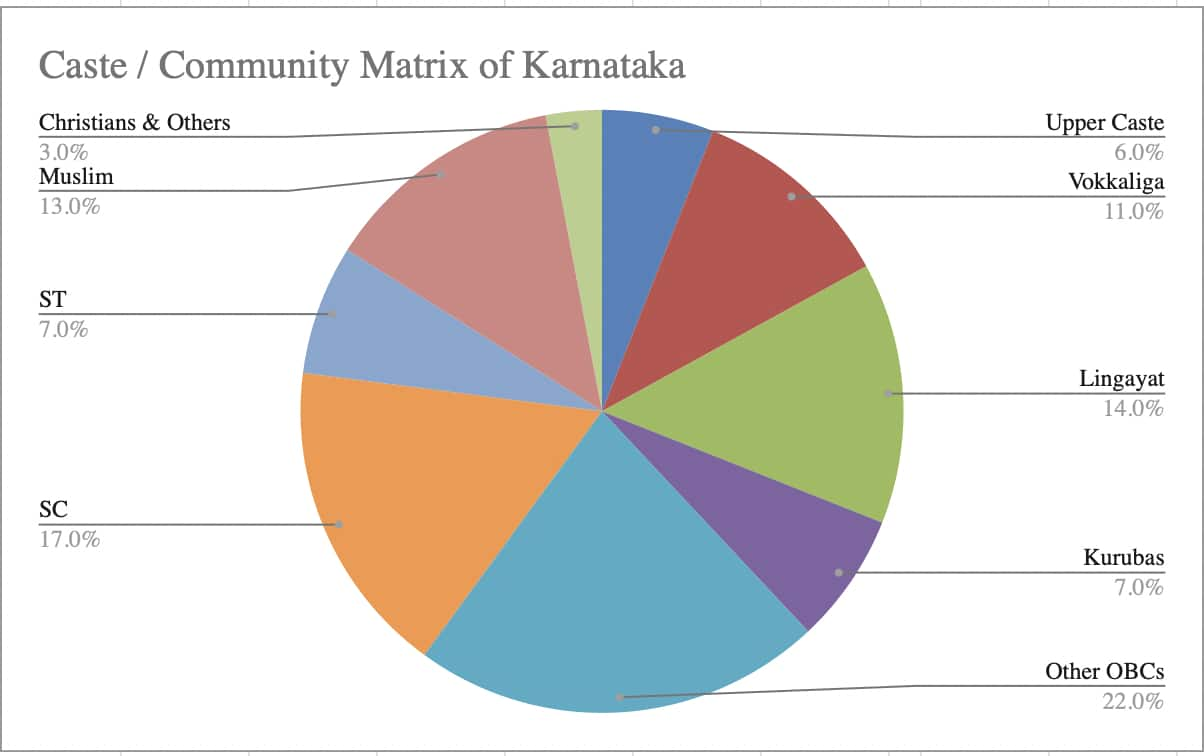



The Karnataka elections atmosphere has been heating up with parties finalising candidates amidst hectic campaigning. Caste plays an important factor in Karnataka as in most parts of the country. With most caste loyalties already fixed, it is the small communities acting as swing voters which may well decide the course of these elections.
 Source: Survey Reports
Source: Survey ReportsLingayats and Vokkaligas are the most dominant and influential groups of the state.
Both are OBCs, however, they are considered to be the forward amongst the backwards just like the Yadavs/Jats in the Hindi heartland. There are more than 700 sub-castes in the OBC list, Kurubas (7 percent), Billavas, Mogaveeras, Vishwakarmas, Kolis etc.
There has historically been a tussle for power between the Lingayats and Vokkaligas in the state. Karnataka has till date had four chief ministers from the Vokkaliga community, and eight have been Lingayats. There have been four CMs from the backward classes while Brahmins have managed to hold the top spot in Karnataka twice.
In the 2018 elections, 100 MLAs (almost half of house strength of 224) belonged to these two communities, 42 Vokkaligas and 58 Lingayats, which is almost twice their population.
Lingayats dominate in North Karnataka, Hyderabad Karnataka and Old Mumbai region. Vokkaligas are the dominant peasant caste of Old Mysuru.
 Source: CSDS / Axis Post Poll Surveys
Source: CSDS / Axis Post Poll SurveysAcronyms like LIBRA and AHINDA are commonly used terms in Karnataka politics. LIBRA which is Lingayat plus Brahmins are anchor voting segments of Bharatiya Janata Party.
AHINDA which is Alpasankhyataru-Hindulidavaru Mattu-Dalitaru (Dalits, Backward Classes & Muslims) have traditionally supported the Congress. The Vokkaligas are largely backers of Deve Gowda’s Janata Dal (Secular).
While BJP CM Basvaraj Bommai and stalwart BS Yediyurappa are Lingayats, HD Kumaraswamy and DK Shivkumar are Vokkaligas. Ex CM Siddaramaiah is a Kuruba.
The Vokkaligas back the JD(S) overwhelmingly only in Old Mysuru where their population on most seats is 15-30 percent. This community is sort of a floating voter in the rest of Karnataka.
Both the BJP and the Congress are attempting to woo this vote bloc: Congress through its state president DK Shivakumar, while BJP through 2 percent additional reservation for the community along with Lingayats.
The OBC Breakthrough (1972)The 1972 elections announced the arrival of OBCs in Karnataka politics when D Devaraj Urs led Congress to victory consolidating AHINDA. After the Emergency of 1975, when Congress was wiped out across India, it retained Karnataka only because of unflinching support of AHINDA.
In 1983 the Congress lost power for the first time primarily because the tall OBC leader S Bangarappa had formed his own party. The OBCs returned to the Congress in 1989, with Bangarappa back in the fold after losing out in the CM race to Ramakrishna Hegde.
In the mid 1990s, some groups veered towards the Janata Dal. In the mid-2000s Siddaramaiah emerged as the tallest OBC leader after his fall out with the Gowdas. He joined the Congress in 2006, revived the AHINDA formation and helped it secure victory in 2013.
With the emergence of the BJP and the relative decline of the Janata Dal(Secular) in the past 15-20 years, OBC votes have been divided in the state. The BJP has captured OBCs such as Mogaveeras, Billavas, Vishwakarmas, Kolis etc from the Congress on the back of its inclusion of social groups under its overarching Hindutva umbrella.
The “Other” OBC VotersMajority voters of big groups like Muslims, Vokkaligas, Lingayats, and SC /STs are already aligned to one of the three parties. The smaller OBCs - non-Lingayat, non-Vokkaliga, non-Kuruba communities - cumulatively accounting for a sizable 22 percent of the population, could emerge as kingmakers in this election.
They switch loyalties depending upon the ground situation. They swung in favour of BJP in 2008 and 2018 helping it emerge as the single largest party.
BJP’s vote share is half of its state vote share in Old Mysuru region. Excluding this region, it would be leading amongst OBCs versus Congress in 2008 and 2013.
 Source: CSDS Post Poll Survey
Source: CSDS Post Poll SurveyMost parties focus on the bigger chunks and ignore these small groups which may be even less than 1 percent of the population and present only in a few pockets. Lower OBCs have their own issues, needs, demands, leadership and do not behave like a homogeneous voting bloc. Hence it requires a lot of effort and resources to conduct outreach activities.
Both Congress and BJP are eyeing lower OBCs to emerge victorious in Karnataka. Which way they will swing could decide the course of this cracker of an election.
Amitabh Tiwari is a former corporate and investment banker-turned political strategist and commentator. Twitter: @politicalbaaba. Views are personal and do not represent the stand of this publication.Discover the latest Business News, Sensex, and Nifty updates. Obtain Personal Finance insights, tax queries, and expert opinions on Moneycontrol or download the Moneycontrol App to stay updated!
Find the best of Al News in one place, specially curated for you every weekend.
Stay on top of the latest tech trends and biggest startup news.